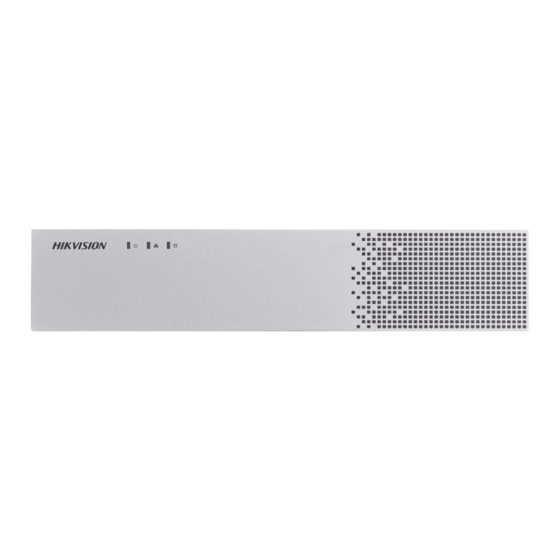
Table of Contents
Advertisement
Quick Links
Advertisement
Table of Contents

Summarization of Contents
Chapter 1 Basic Operation
1.1 Activate Your Device
Activate the device by setting an admin password.
1.2 Configure TCP/IP Settings
Configure TCP/IP settings for network operation.
1.3 HDD Settings
Ensure video recorder storage media is well and initialize it.
1.4 Add Network Camera
Add network cameras to the connection list for live video.
1.5 Platform Access
Configure ISUP and Guarding Vision for third-party access.
Chapter 2 Camera Settings
2.1 Configure Image Parameters
Customize image parameters like day/night switch, backlight, contrast.
2.2 Configure OSD Settings
Configure On-screen Display settings for camera, including date/time.
2.3 Configure Privacy Mask
Conceal parts of the image from live view or recording.
2.4 Import/Export IP Camera Configuration Files
Save, back up, and import IP camera configuration for devices.
2.5 Upgrade IP Cameras
Remotely upgrade IP camera firmware through the device.
Chapter 3 Live View
3.1 Start Live View
Display video images from each camera in real time.
3.2 Configure Auto-Switch of Cameras
Set auto-switch of cameras for playing in different display modes.
3.3 Configure Live View Layout
Configure custom live view layouts for different camera arrangements.
3.4 Configure Channel-Zero Encoding
Enable channel-zero encoding to decrease bandwidth for remote viewing.
3.5 Main and Auxiliary Ports Strategy
Configure video output types and priority for HDMI, VGA, LCD, etc.
3.6 Digital Zoom
Zoom into live images with different magnifications.
3.7 Fisheye View
Expand fisheye camera views in Live View or playback mode.
3.8 3D Positioning
Zoom in/out a specific live image area for detailed views.
3.9 Live View Strategy
Select live view strategy for real-time performance.
3.10 Facial Recognition
View real-time facial recognition and stranger recognition results.
3.11 PTZ Control
Control Pan, Tilt, Zoom functions of PTZ cameras.
Chapter 5 Event
5.1 Normal Event Alarm
Configure motion detection, video loss, and tampering alarms.
5.2 VCA Event Alarm
Configure video content analysis (VCA) events like loitering and gathering.
Chapter 6 Smart Analysis
6.1 Engine Configuration
Configure engine working modes for VCA types.
6.2 Task Configuration
Manage smart analysis task status and auto analysis.
6.3 Face Picture Comparison
Perform face picture comparison and capture for recognition.
6.4 Perimeter Protection
Detect objects crossing lines or entering/exiting regions.
6.5 Human Body Detection
Detect and capture human bodies for analysis and search.
6.6 Multi-Target-Type Detection
Detect faces, human bodies, and vehicles simultaneously.
6.7 Vehicle Detection
Detect vehicles and capture license plates for traffic monitoring.
6.8 Target Detection
Detect smart, facial, vehicle, and human body targets in live view.
6.9 People Counting
Count people and generate reports for analysis.
6.10 Heat Map
Analyze user traffic and stay duration in specific areas.
Chapter 7 File Management
7.1 Search Files
Specify conditions to search videos and pictures.
7.2 Export Files
Export files for backup purposes to USB or eSATA HDD.
7.3 Smart Search
Search human body, face, and vehicle files using smart search.
Chapter 8 Storage
8.1 Storage Device Management
Manage SSDs, HDDs, and disk arrays for storage.
8.2 Disk Array
Combine multiple physical disk drives into a single logical unit (RAID).
Chapter 9 POS Configuration
9.1 Configure POS Connection
Connect to POS machine/server to overlay transaction messages.
9.2 Configure POS Text Overlay
Overlay POS characters onto live view or playback images.
9.3 Configure POS Alarm
Trigger actions like recording or monitoring based on POS events.
Chapter 10 Hot Spare Recorder Backup
10.1 Set Hot Spare Device
Configure a hot spare device to take over when a working device fails.
10.2 Set Working Recorder
Configure the hot spare recorder to work as a normal recorder.
10.3 Manage Hot Spare System
Manage the hot spare system by linking working recorders.
Chapter 11 Network Settings
11.1 Configure DDNS
Set up Dynamic DNS service for network access.
11.2 17.3 Configure PPPoE
Configure user name and password for PPPoE Internet connection.
11.3 Configure Port Mapping (NAT)
Map ports for remote access via UPnP or manual mapping.
11.4 Configure SNMP
Configure SNMP settings for device status and parameter information.
11.5 Configure Email
Configure email notifications for specific events.
11.6 Configure Port
Configure different types of ports for relevant functions.
11.7 Configure ONVIF
Configure ONVIF protocol for connecting third-party cameras.
Chapter 12 User Management and Security
12.1 Manage User Accounts
Add, edit, and manage user accounts and their permissions.
12.2 Manage User Permissions
Assign operating permissions for local and remote device access.
12.3 Configure Password Security
Configure security questions, GUID files, and reserved email for password recovery.
12.4 Reset Password
Reset admin password using GUID, security questions, or reserved email.
Chapter 13 System Management
13.1 Configure Device
Configure device settings like language, output standard, and name.
13.2 Configure Time
Configure time synchronization via manual, NTP, or DST.
13.3 Network Detection
Monitor network traffic and test delay/packet loss.
13.4 Storage Device Maintenance
Perform bad sector, S.M.A.R.T., and health detection on storage devices.
13.5 Upgrade Device
Upgrade device firmware via local backup or FTP server.
13.6 Import/Export Device Configuration Files
Back up and restore device configuration files.
13.7 Search & Export Log Files
Search and export system logs for troubleshooting.
13.8 Export Diagnostic Information
Export diagnostic information for troubleshooting issues.
13.9 Restore Default Settings
Restore device settings to factory defaults.
13.10 Security Management
Configure RTSP, ISAPI, and HTTP authentication for security.
Chapter 14 Appendix
14.1 Glossary
Definitions of technical terms used in the manual.
14.2 Frequently Asked Questions
Answers to common questions about device operation and troubleshooting.










Need help?
Do you have a question about the iDS-7716NXI-I4/16P and is the answer not in the manual?
Questions and answers